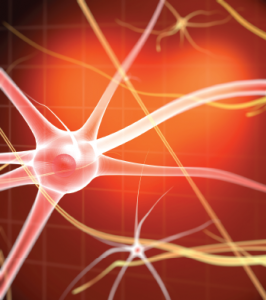
Giovanni Cancemi/shutterstock.com
CHICAGO—Delia Chiaramonte, MD, associate director of education at the Center for Integrative Medicine at the University of Maryland School of Medicine in Baltimore, presented the newest thinking on pain to a gathering of rheumatologists at the ACR’s State-of-the-Art Clinical Symposium in April. She began by explaining that pain is more than nociception. Nociception stimulates nerves to send information to the brain, and pain is the subjective perception of that information. As such, it is affected by emotions, genetics and social connections.
The central nervous system (CNS) can change, distort and amplify pain such that the symptoms no longer directly reflect the peripheral noxious stimuli. This central sensitization amplifies neural signaling and elicits pain hypersensitivity. “The CNS is distorting how much pain there is,” explained Dr. Chiaramonte, adding that this phenomenon may underlie fibromyalgia.
“It turns out that there are signals from the brain that amplify pain,” she noted. The brain receives a sensation and then “decides” if it is hurt. Moreover, the greater the perception of threat, the greater the pain. Thus, people who are anxious and feel threatened throughout the day feel more pain. Likewise, “patients who catastrophize have more pain,” added Dr. Chiaramonte. “That is so important for us to know, because we can teach people to stop catastrophizing.”
Experts consider patients who catastrophize pain to have a maladaptive cognition. Other maladaptive cognitions that contribute to an enhanced experience of pain include fear of pain, hypervigilance and kinesiophobia. These cognitions can combine with pain enhancers that include muscle tension, anxiety/depression and self-blame/guilt. The integrative approach to pain management addresses all of these components of the pain response. It can include, for example, cognitive behavioral therapy, medications and acupuncture. A key concept in integrative pain management is the mind–body connection.
‘Patients who catastrophize have more pain,’ added Dr. Chiaramonte. ‘That is so important for us to know, because we can teach people to stop catastrophizing.’
Mind–Body Techniques
Mind–body techniques help with pain management because they can aid in the management of anxiety and the sensation of threat. These techniques, such as meditation, guided imagery and biofeedback, are designed to stimulate the relaxation effect. “The one that’s best is the one that the patient likes and the one that the patient will do,” said Dr. Chiaramonte.
She described in some detail one standardized program developed to reduce the suffering of people in chronic pain: mindfulness-based stress reduction (MBSR). The eight-week group experience requires patients to perform 45 minutes a day of meditation at home. Those who did so experienced increased pain tolerance and lowered pain/distress. They also had decreased pain intensity, reduced emotional distress and improved sleep quality relative to patients in the placebo group. The effect of MBSR is not only the subjective report of patients, but also can be seen objectively by imaging with functional magnetic resonance imaging (fMRI).
Many mind–body techniques emphasize breathing and teach patients that it is better to have slower breathing into the belly as opposed to more rapid chest breathing. This breathing awareness can be incorporated into meditation, which she described as the process of focused attention. Individuals can meditate by focusing on the breath, but they can also meditate by drawing their attention to a word/phrase, a candle or footsteps. No matter the focal point, the goal of meditation is to gently bring the mind back to focus whenever the mind wanders.
Research has shown that meditation changes the way the brain processes information, including pain information. Specifically, one study found that patients who were trained in mindfulness meditation for four days experienced a 57% reduction in pain unpleasantness and a 40% reduction in pain intensity.1 The meditation-induced reductions in pain intensity were associated with increased activity in the anterior cingulate cortex and anterior insula, the regions of the brain involved in the cognitive regulation of pain processing. Thus, although people who meditate continue to feel pain, they are able to live their lives with less disruption from the pain than people who do not meditate.
Guided imagery can also be an effective tool for pain management. It has been shown to decrease postoperative pain, improve fibromyalgia and possibly improve musculoskeletal pain. Dr. Chiaramonte suggested that healthcare providers visit www.healthjourneys.com for a catalogue of effective guided imagery programs.
Moving meditation, such as low-intensity yoga or tai chi, may also help with pain management. Some yoga classes can be very difficult, and hot yoga classes, in particular, should be avoided. However, the right yoga class can improve physical functioning and psychological health in sedentary adults with osteoarthritis and/or rheumatoid arthritis. Specifically, it can improve walking capacity, decrease pain and improve health-related quality of life. Iyengar yoga is one example of a calmer, more restorative form of yoga, and women with rheumatoid arthritis who performed Iyengar yoga had improved health-related quality of life, decreased pain disability, improved mood, decreased fatigue and improved self-efficacy.1
Conclusion
Integrative pain medicine brings many benefits to the patient, including decreased systemic inflammation and improved management of sleep and stress. Dr. Chiaramonte described in detail valuable mind–body techniques, such as guided imagery, MBSR and meditation, and she also reminded the audience that chiropractic care, massage and acupuncture can also be useful tools for pain management. Finally, she suggested that physicians consider recommending that patients try biologically active supplements, such as fish oil, probiotics and vitamin D.
Lara C. Pullen, PhD, is a medical writer based in the Chicago area.
References
- Evans S, Moieni M, Lung K, et al. Impact of Iyengar yoga on quality of life in young women with rheumatoid arthritis. Clin J Pain. 2013 Nov;29(11):988–997.



